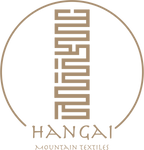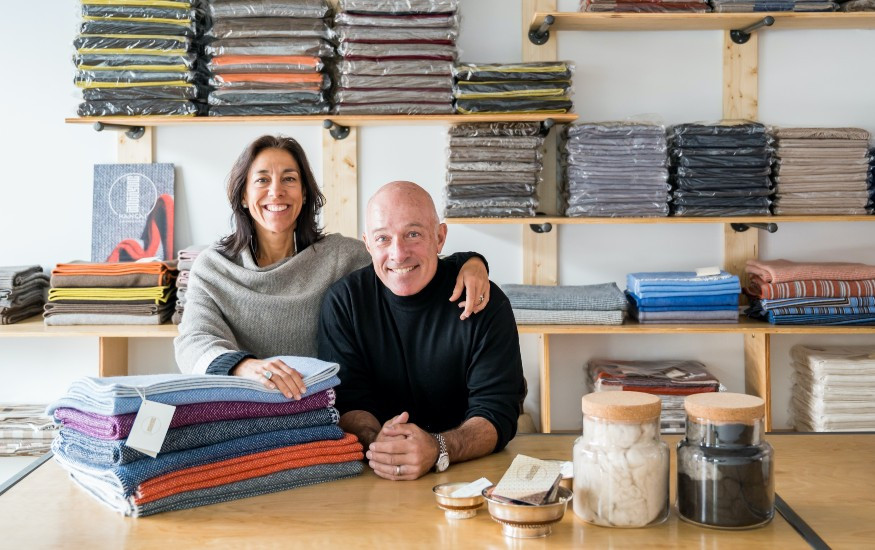Interview with Studio Zung in NYC
Posted by WRITTEN BY SARAH HEE JOO HAHN on Nov 11th 2021
ARTISAN WEDNESDAY | BETINA AND BILL INFANTE FROM HANGAI MOUNTAIN TEXTILES
To gather a deeper and more intimate connection with the artists and artisans we work with, we asked each to answer a series of questions. We will be showcasing each Q+A in correlation with our familial content. Enjoy!x Shop Zung
Without giving away your location, describe where you are right now. What are the things you see, smell, or hear around you?
Old oak trees shrouded in Spanish moss line shaded streets. The cicadas' songs ebb and flow like waves. History hangs heavy in this web of hot, southern air, and although I enjoy seeing the magnificent historic homes, the history is, at times, overwhelming. We are just passing by, like nomads, as this is not home, and we’re looking forward to getting back to our blue skies, crisp mountain air, and cold, clear rivers.
Taste, touch, smell, sound, sight — which of the five senses do you rely on the most? Why?
That’s such a tough question because we’re foodies and music aficionados, but we agree that sight is the sense that yields the most wonder. We live high in the Rocky Mountains and love the sight of snow-capped mountains in winter, and cathedral forests towering over streams and rivers swollen with winter run-off.
But we also think back to our adventures in Mongolia, where earth meets sky, kites and golden eagles soar overhead, bright green steppe is stippled with goats and sheep, and the slopes of the Hangai Mountains are home to the yak whose down is hand harvested by nomadic herders wearing brightly-colored deel (outer jackets) every spring. Though the smells and sounds of the Mongolian countryside evoke powerful memories, the sight of our own children on horseback riding with eagle hunters, or rosy-cheeked Mongolian children greeting you from orange and blue-painted doors of their gers (aka yurt) are indelibly etched in our minds.
Tell us a little bit about your background. How did your journey begin in creating Hangai Mountain Textiles?
My husband, Bill, and I moved overseas in 1993 to work in development. We’ve lived and worked in Sri Lanka, Bulgaria, Serbia, Indonesia, and Mongolia. We arrived in Mongolia in January 2006 to work with The Asia Foundation, and shortly after I founded Breakthrough Communications, the country’s first international marketing and communications agency, which kept us in Mongolia for almost 10 years.

When we began our move back to the States and settled in Basalt in 2015, we saw an opportunity to promote Mongolia’s extraordinary fibers, and to contribute to rural livelihoods and the preservation of nomadic culture that are inextricably tied to herding and grazing. It literally began on a cool August evening, as we sat on our terrace watching a spectacular moon rise. The evening was magnificent as the stars began to shine and the temperatures began to fall. As we and a dear friend began to feel the chill, we reached for the Mongolian throws that we had purchased for our own home. This was our Eureka moment! The throws and blankets warmed us up and became the source of conversation and speculation: Why not promote Mongolia’s finest fiber for homes and luxury hotels in the U.S. The very next day we began exploring the possibilities and set upon creating a sustainable, luxury brand that would give back to a country that we know and love.
Today, we are working with Mongolian and American entrepreneurs to build a global brand that showcases Mongolia’s luxurious natural fibers that have been hand-combed by herding communities for centuries.
For those of us who haven’t been to Mongolia, or the Hangai mountains, could you describe it to us? What makes it a special place?
Mongolia is a spectacular country with vast open spaces. It’s the land where sky meets earth and where the landscape is peppered with herds of animals and dotted with gers (ge-hers aka yurts).

Mongolia, sandwiched between China to the South and Russia to the North, is known for its vast, rugged expanses and nomadic culture.The country, (about the size of Alaska), is sparsely populated with only 3.2 million people, of which approximately 50% live in the coldest capital in the world, Ulaanbaatar.
For centuries herding families and communities have hand-combed yak and camel down and cashmere that they have used to knit or weave clothing and household products. Rare yak fiber is our passion because it’s exquisitely soft, warm and exotic. The yak down that is used to weave and knit our throws and blankets is sourced largely from the Hangai mountains in Mongolia’s heartland, and which inspired our brand name.

The social impact your company champions and your pillars of fair trade, local empowerment, and traceability are values we hope more brands thread into their ethos. How was that process like building a relationship with local herder families, knitters, and weavers? Did you run into any obstacles in your journey?
Mongolia is the second largest producer of cashmere in the world, but 90% of its cashmere is exported in raw or minimally-processed form to China, Scotland, Italy and other countries for processing, knitting and weaving. This leaves little fiber for local manufacturers, and exports virtually all of the benefits, the value-added, to foreign countries. When we launched Hangai, we made a commitment to produce exclusively in Mongolia to ensure that our production benefits the Mongolian the many herder families to knitters and weavers with whom we partner.

We currently produce our knit and woven blankets and throws with three Mongolian firms that purchase their fiber from cooperatives and associations that work directly with the herder families who raise and comb their yak, goats and camels every spring and early summer. We work to ensure that the farm families who anchor our value chain receive a fair market price for their fiber, and we have pushed for more transparent and stable pricing.
Sustainable production is multi-dimensional and it begins with herding, which has been central to Mongolia’s cultural identity for centuries. Sustainable herding means stocking at rates that maintain natural flora, diverse herd composition, rotational grazing, and avoiding areas that are critical to native fauna, such as argali sheep, ibex, and snow leopards. Hangai is working with a coalition of pasture-user groups, associations, cooperatives, environmental non-governmental organizations, and local and international businesses to create a sustainability standard that can be monitored and enforced. Herders, cooperatives and associations that practice sustainable herding will be rewarded with higher prices and will benefit directly from a “sustainability premium” that helps to protect fragile steppe ecosystems and montane habitat.
Traceability is key to sustainability. Knowing the origin of fiber, tracing it to the province (aimag), county (soum), town (bagh) and herder level, is essential to enhancing herding practices that contribute to sustainability. Tracing fiber to its source is complicated but is essential to the veracity and integrity of any sustainability standard. Sophisticated block chain technologies have been used to trace coffee, cocoa and other commodities, and Hangai Mountain Textiles is working with a collection of partners to adapt block chain traceability to the Mongolian fiber market.
We want to know more about your design process, walk us through it. How do you begin designing your textiles? Do you anchor it with an image, a material, color, feeling?
Most of our designs are conceived in our Colorado showroom and inspired by art and other visual triggers. One of our collections pays homage to the legendary Bauhaus weaver, Annie Albers whose husband Josef, quite literally, wrote the book on color-field theory. These and other artists inspire our design, many of which are simple and clean, but which employ different knit-types that bring distinctive touch and feel. Inasmuch as we ourselves conceive new designs and combinations of color, we have also adopted suggestions from our partners in the U.S. and in Mongolia. We carry a core collection of throws, but every year we add something new.
How would you describe your work? How do other people describe your work?
Fun. Exciting. Meaningful.
The last customer that found us said: “I’ve heard that you are the only ones in Aspen who can produce throws of the same quality of Hermes.”
Think of an object in your home that has the most significance to you. Could you share with us what it is and the memory behind it?
I have an oil painting by an Argentine artist named Marta Zuick. It’s bright and abstract. I loved that piece when I first saw it decades ago – I was a teenager. My father was an artist in many ways. He had owned an art gallery and our home was filled with art. I had mentioned that I loved the piece to my father. He later gifted it to me for my birthday – it was the first piece of art I owned. Since then, Bill and I have filled our home with artwork from around the world that we collected while living and working in Mongolia and other exotic countries.
We live in a society where so much of our identity is surrounded by the things we consume whether that be the things we buy, the food we eat, or the content we see, along with the fast paced nature of it. How do you approach mindful living and sustainability in the context of your work and in your everyday life?
I work on mindfulness. I do yoga. I reuse, recycle and try to live my life without waste, in the outdoors, and with purpose. I encourage my children to be curious, to question and search for deeper understanding of issues and directly exposing them to cultures, societies and economies around the world to inspire consciousness and mindfulness.
Regarding Hangai, sustainable production refers to every step of fiber processing, from combing through manufacturing and finishing. Hangai products are knit and woven with fiber that is 100% hand-combed from yak, cashmere goats and camels. This process is entirely “animal safe.” Our yak fiber is completely natural - unbleached and un-dyed. For those fibers (cashmere and camel) that are bleached and dyed, we work to minimize water consumption and dispose of all wastewater responsibly. Our partners use natural Swiss-made dyes that yield deep colors that are environmentally safe.
What do you envision for your brand in five years?
I would love for Hangai to become recognized across the U.S. for the values we uphold and for extraordinary quality that supports the traditions and culture of Mongolia where we source our product. We are extremely proud that we are the only U.S. source of luxurious textiles that are produced entirely in Mongolia – from the herders who hand-comb the yak and goats, to the processors who wash and spin the fiber, to knitters and weavers – every step of our production takes place in Mongolia. As we grow our business with designers, specialty retailers and luxury hospitality owners, we are committed to supporting Mongolia’s ongoing development, and to promoting traceability, which ensures authenticity and is essential to sustainability.
What do you want people to take away from your brand? How do you want to be remembered? What is the legacy you imagine for your brand?
Hangai Mountain Textiles – a sustainable luxury brand with authentic purpose.
We want to be remembered for the rare quality of our products that are inextricably linked to the preservation of Mongolian herding traditions and culture, and to promoting Mongolia’s development.

Original interview: https://www.shopzung.com/blogs/news/artisan-wednesday-betina-and-bill-from-hangai-mountain-textiles

